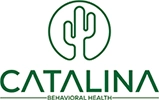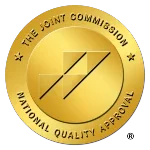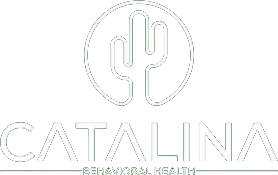The Nature of Trauma Treatment and the Trauma Tree Approach
The Trauma Tree model provides people who have experienced trauma a way to visualize their emotional responses to trauma. It uses something everyone understands – a tree and its parts – as a representative image.
Catalina Behavioral Health, Tucson’s leading trauma-informed treatment center, believes in using many models to end the suffering of trauma. Our JCAHO-accredited facility provides a safe environment where clients can express the emotions of their trauma and learn how to reshape the resulting behaviors. Different people respond to traumatic events uniquely, with each having a different healing process.
Our helpful, free download (PDF) trauma tree is just one tool to help support your healing journey. Keep reading to discover how to put the PDF to use, and remember we are always here to help with additional support.
Get Confidential Trauma and PTSD Assessment
Learning from Your Emotional Responses to Historically Significant Events
Let’s start by acknowledging that the trauma tree PDF best supports your growth when completed in combination with therapy.
While there is no harm in completing the PDF, it takes a variety of treatment methods to get to the heart of PTSD and fully heal.
What the Trauma Tree Does
The trauma tree PDF can:
- Help adults visualize the connections between traumatic events, beliefs, symptoms, and behaviors
- Shows how past trauma can underly present struggles, including substance use, depression, or anxiety
- Makes one notice invisible trauma by mapping out the tree’s growth
- Guides treatment by helping patients and therapists find the roots of causes, not just the symptoms at the surface
- Normalizes trauma responses, showing that they come from a place of survival.
The words you write as you complete your trauma tree PDF can be healing and freeing, but they are not a cure-all.
What the Trauma Tree Doesn’t Do
Here’s what NOT to expect from the trauma tree PDF:
- It doesn’t provide an accurate clinical diagnosis
- There are no quick fixes; it only recognizes your trauma patterns (which is admittedly a great first step!)
- The PDF does not replace the need to speak with a trained recovery specialist or counselor
- It does not imply the person is broken; it shows how the person has adapted to survive a lifetime of pain
- Finally, it doesn’t capture every last detail about your trauma; it’s a starting point, not the end game
While our PDF can support healing and personal development, it can’t explain how to work through your pain.
The Trauma Tree Maps Growth from Childhood Development to Adulthood
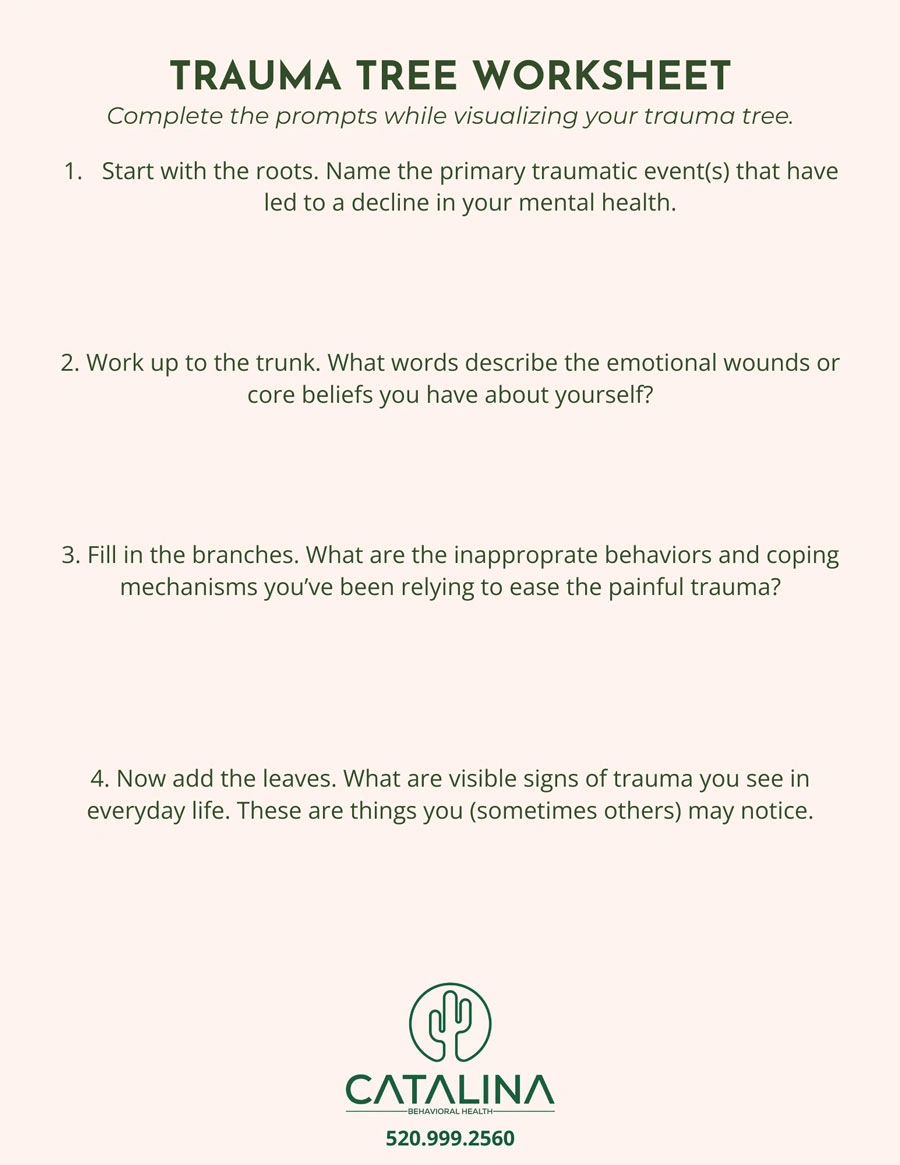
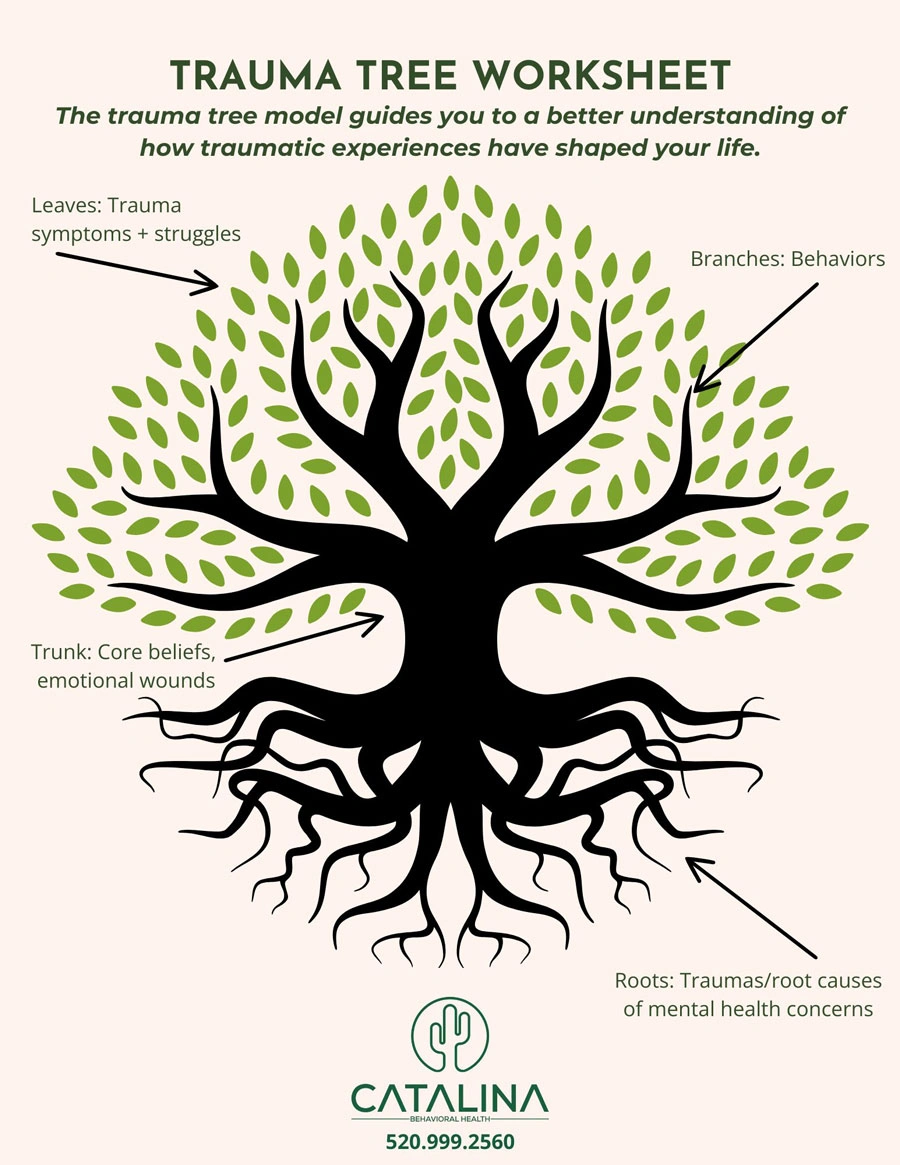
The trauma tree contains four key components. Starting from the ground up, you fill in the:
- Roots
- Trunk
- Branches/limbs
- Leaves
Keep reading to fully understand each component before you download your PDF and create your own trauma tree.
The Roots of Trauma Often Take Hold in Childhood
Many children begin their lives in turmoil or chaos – almost from birth. The smallest among us are at the greatest risk of feeling the impact of trauma. Think back to infancy and childhood traumas, and work into your teen years and adulthood as you consider the roots of your traumatic memories.
The world is full of many types of trauma. Write down anything you can think of – there’s no “wrong” answer. List your experienced trauma as the roots, such as:
- Parents who verbally or physically fought or abused each other
- Born into poverty or going without enough food
- Lack of housing or safety in childhood
- Surviving natural disasters, immigration, war
- Poor access to education
- Using drugs or alcohol in childhood or as an adult
- Divorce (parents or self)
- Severe injury, illness, accidents
The roots are covered by the ground and unseen to the world. Still, these roots feed the whole tree, which means unresolved traumatic injury can spread throughout the tree.
The Trunk Represents Self-Beliefs and Emotional Wounds
The roots form the trunk, the support structure of the rest of the tree.
In our PDF, it represents core self-beliefs and emotional wounds that grow from the roots up. Here are some examples of self-beliefs that can block your body’s ability to heal:
- “I’m not worth anyone’s love, even my own.”
- “The world is dangerous beyond hope.”
- “I have completely failed at recovery and am doomed to a life of addiction.”
These deep emotions uphold these negative beliefs, which come from a place of shame, fear, or sadness. However, it also tells an undeniable truth – survival against all odds.
The Branches (Limbs) Represent Behaviors and Coping Tools

Children start learning how to cope and self-soothe as a baby, transferring and upskilling as they mature into early childhood. But many don’t flourish due to the trauma, never mastering self-empathy or becoming secure in their own identity.
They may act out (children and adults!). Here are some of the behaviors that may be present:
- Substance abuse
- Anger
- Self-isolation
- Perfectionism
- Co-dependency
- People pleasing
- Identity struggles
These may have been initially helpful coping tools. However, they can affect them negatively as they find new ways to deal with their traumatic pain.
Get Accredited Treatment Programs at Catalina
Leaves Are Representative of the Struggles in Our Lives
You finish the PDF exercise by filling in the leaves, or the struggles and symptoms we face in our lives. These are things that we see ourselves; close people in our lives may also see them:
- Anxiety
- Depression
- Panic attacks
- PTSD
- Nightmares and Sleeplessness
- Relationship problems (with family, children, and love interests)
- Moodiness
- Chronic pain
- Headaches
Like real leaves on a tree, these can shift, blow away, and re-emerge, but have ultimately come from the roots that nourish the entire environment.
Allie Gained Hope and Understanding by Using the Trauma Tree
‘Allie’ learned how trauma could affect her life…as well as her children. She’d grown up in a poor environment. Her parents barely made ends meet, and when her dad hit a breaking point, he walked out on his wife and children. Her mother had chronic health issues; with no money to see a doctor, Allie watched her mom’s health decline constantly. By the time Allie was 12, her mother had passed away; her father was nowhere to be found, so the little girl went into foster care.
Allie vowed to work hard to create a better life when she grew up. That worked for a while. After she had children, her life began to mirror her parents’ marriage. She and her husband divorced; she couldn’t afford the mortgage alone and lost the home she’d provided for her children.
She moved the kids to a small apartment; the feeling of failure became inescapable. In ever-growing despair, Allie told herself that she was a lousy mother, a feeling she could never quite shake off. She started drinking heavily to fall asleep at night.
Gaining an Understanding of Untreated Trauma

Soon, Allie became addicted to alcohol and saw she was losing control of her life. She needed help and learned that Catalina accepted her employer’s insurance plan. Allie found that outpatient treatment let her balance being a mom, employee, and trauma patient.
Working with a counselor, Allie completed the Trauma Tree PDF. It helped her understand how the flow of trauma started at the roots and branched into her daily life.
With that visual, Allie threw herself into her therapy and worked on resolving her childhood pain. By the end of her time at Catalina, Allie had become kinder to herself and a better mom to her little ones. She has still not forgiven her ex-husband, but she’s working on that. She attends AA meetings every week to hold herself accountable for her sobriety.
Up To 100% of Rehab Costs Covered By Insurance
Reach Out to Catalina if You’re Tired of Living With PTSD
If the constant pain of your traumatic experience continues to hold you back in life, it’s time to seek professional help. Completing a PDF is not enough. Our team will work hard to help you find the exact causes of your pain and replace the harmful survival tools you’ve adopted with healthier methods.
Call Catalina today – your call to our Tucson, Arizona, treatment facility is free and confidential.

